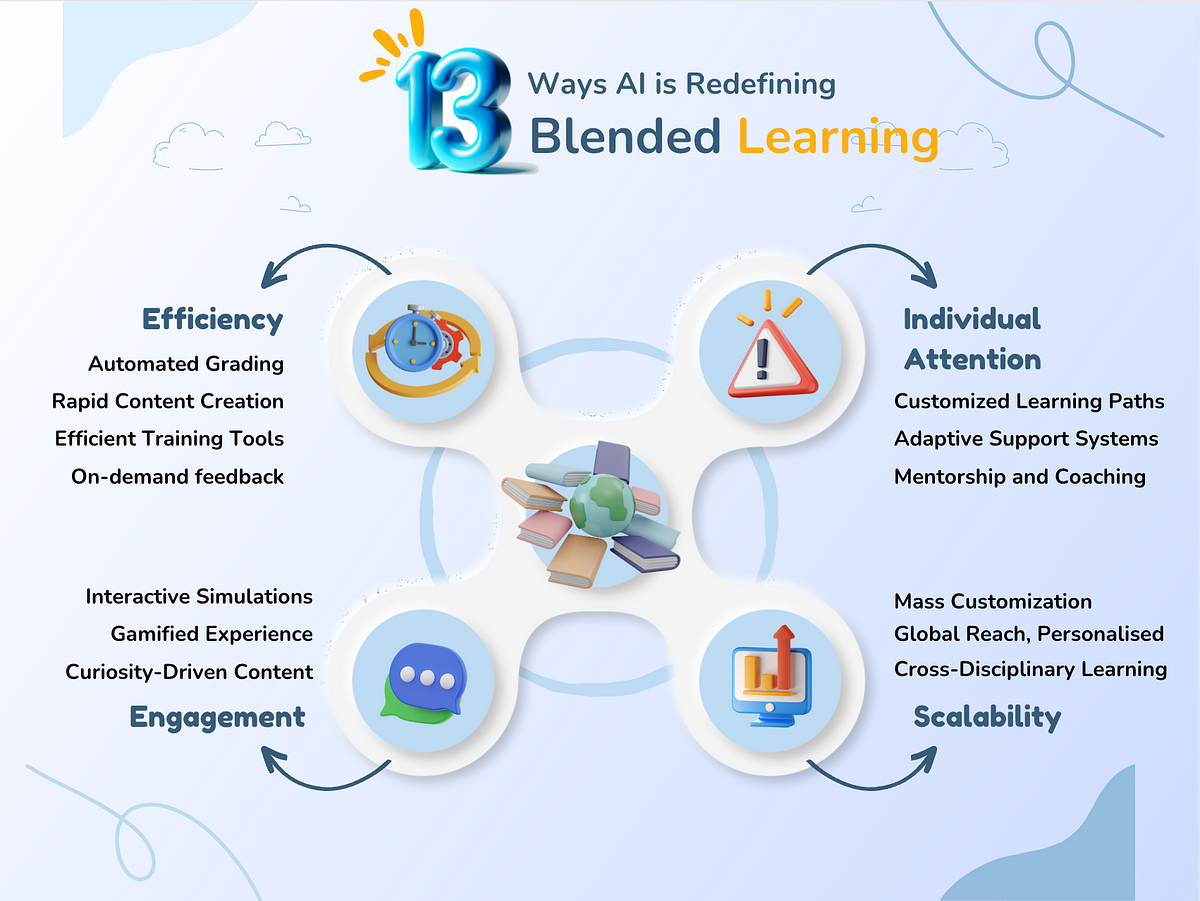Revolutionise Your Teaching — Top AI Innovations Redefining Blended Learning

Revolutionise Your Teaching — Top AI Innovations Redefining Blended Learning
Generative AI and LLMs: The Future of Effective, Engaging Educational Training
Blended learning mixes online teaching tools with regular classroom activities — the approach has significantly transformed the educational landscape over the past decade, offering more flexibility and diverse learning experiences.
But never has there been an online teaching tool quite as groundbreaking for education — than generative AI; from this point it isn’t just about enhancing how we teach so much as completely redefining it.
In this article, we’ll explore several ways generative AI models — like ChatGPT — are revolutionising blended learning, particularly for educators in workforce training; we’ll delve into how this cutting-edge technology is not only streamlining educational processes but also opening new horizons for educators and training academies alike.

1. Efficiency
Ever imagined a world where grading papers is as easy as clicking a button?
With Gen AI, this is no longer a fantasy. Technologies like automated grading and rapid content creation are not just buzzwords; they are active tools enhancing educational efficiency right now.
By integrating AI into blended learning, educators are already saving countless hours, making room for more innovation in teaching and personalised attention to students.
Automated grading systems can assess assignments in seconds, providing instant feedback to students. Rapid content creation tools enable educators to design courses tailored to diverse learning needs, while on-demand feedback mechanisms ensure constant student engagement and learning optimisation.
Efficiency in blended learning is not just about doing things faster; it’s about transforming the educational experience and giving people the time to focus on what truly matters — engagement and comprehension. By incorporating AI tools such as automated grading and rapid content creation, educators can optimize their workflow and devote more energy to developing innovative teaching strategies and curricula that cater to diverse learning styles — and be there in the flesh for more of those instances where it makes all the difference.
2. Scalability
Okay, great, so AI can help educators be more efficient — but scaling educational efforts often comes with the risk of diluted quality.
Can we expand without losing the essence of effective teaching?
The efficiency brought by AI is not just about streamlining processes; it’s about empowering educators and institutions to expand their reach. As we harness AI’s potential for efficiency, we unlock new possibilities for scalable, quality education.
It’s not about the AI doing everything so much as it helping educators to do MUCH more.
It is now possible for personalised AI “Coaches” — with their own unique persona as well as in-depth knowledge and access to the training content — to be rolled out en-masse.
Educational institutions are already leveraging AI such as this to scale their offerings, showing that quality education can indeed grow in tandem with demand.
Section 3: Individual Attention
Each student is unique, but traditional teaching methods often overlook this fact; ever felt like just another face in a crowded classroom?
AI technologies are changing this too, with AI-driven personalised learning paths, each student receives individual attention that adapts to their unique learning style and pace.
Imagine those digital tutors we mentioned knowing not only the subject matter but also how you learn best, providing guidance and resources specifically suited to your needs, as they arise.
Studies have shown that personalised learning can lead to significant improvements in student outcomes — and so AI’s ability to analyse learning patterns and provide custom-tailored content, even on-the-fly, is a game-changer in education.
While scalability addresses the quantity of education, AI’s ability to provide individual attention ensures the quality remains high, no matter the number of students — even more so with experienced educators utilising AI tools.
This personalised approach by AI not only caters to each student’s unique needs but also empowers teachers to be more effective. By automating the analysis of learning patterns and adapting content accordingly, educators can focus on what they do best — teaching and inspiring.
Section 4: Engagement
Have you ever found yourself so completely absorbed in something that time seemed to ‘cease to exist’?
This state, often referred to as ‘flow,’ is the holy grail of learning engagement.
Engagement is not just a nice-to-have in education; it’s the cornerstone of effective learning. Yet, capturing and maintaining this level of engagement has always been a formidable challenge.
Engagement is not just a nice-to-have in education; it’s the cornerstone of effective learning.
In this meta-analysis study, researchers investigated the impact of technology-supported personalised learning and found that it had a statistically significant and positive effect on learning outcomes — and, what’s more, the more personalised the learning, the greater the positive outcomes!
With AI, we will start to see corporate training programs where AI tailors scenarios to reflect an employee’s current project, enhancing relevance and engagement.
For example, a sales training module could adapt to present negotiation scenarios based on relevant, real-life customer interactions — keeping trainees deeply involved.
Similarly, consider a leadership development course using AI to offer personalised feedback, drawing from each participant’s unique work experiences, learning pace — and even the answers they provide in real-time!
This level of customisation ensures that the learning experience is not just informative but also deeply engaging.
Conclusion
To tie this up, it is clear that generative AI is revolutionising Blended Learning; it makes educators more efficient — allowing them to scale larger and faster, and it ensures quality is not lost at this scale, providing individualised attention to each and every learner to ensure they become and remain deeply engaged.
Instead of replacing educators, AI is here to give them superpowers, enabling a more effective and engaging training & learning experience.
The future of education is a collaborative one, where educators and AI work together to empower learners — jump on board!
Weld this to your inbox & spark your creativity
If this vision resonates with you and you are wondering where to begin, I encourage you to reach out directly to us at Beeline. We are an innovative Knowledge Community and Academy Platform — for the future! Let’s discuss how we can adapt and grow together in this transformative era!

If you like my writing, subscribe to my list to receive occasional emails about whatever I am digging into and feel will be valuable to you creatively :)